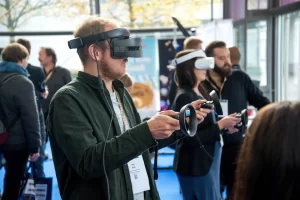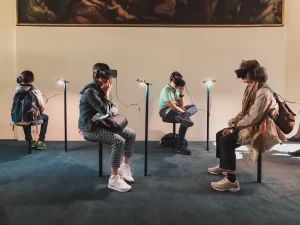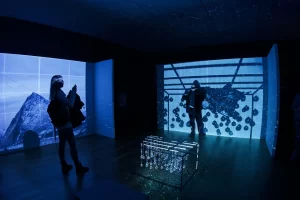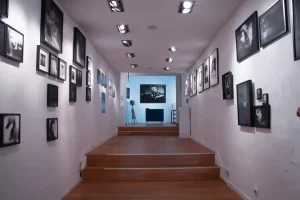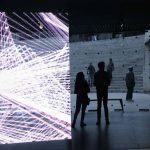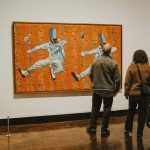Introduction to Virtual Art Exhibition Tours
Exploring the Art World Beyond Boundaries: A Deep Dive into Virtual Art Exhibition Tours
Art has the power to transcend physical spaces, but what if you could experience the masterpieces of the world without leaving your home? Welcome to the realm of Virtual Art Exhibition Tours, a groundbreaking way to explore art that knows no boundaries. Imagine standing before the Mona Lisa or strolling through the halls of the Louvre—all from the comfort of your living room.
In this article, we’ll unravel the layers of virtual art tours, breaking down barriers, navigating digital galleries, exploring benefits beyond access, and peering into the future of this transformative art engagement.
Introduction
Picture this: You’re standing in the ethereal glow of Vincent van Gogh’s “Starry Night,” surrounded by an atmosphere pulsating with artistic brilliance. This isn’t a dream; it’s the magic of virtual art exhibition tours, where art comes to life in your hands.
Virtual art exhibition tours are immersive digital experiences that bring art collections to your fingertips. Unlike traditional online galleries, these tours employ advanced technologies like 3D scanning, virtual reality (VR), and augmented reality (AR) to recreate the ambiance of a physical museum.
In an era marked by technological leaps, virtual art exhibition tours emerge as more than just digital replicas; they are a key to unlocking the vast world of art, fostering inclusivity, and shaping the future of artistic encounters.
Virtual art exhibition tours are immersive digital experiences that bring art collections to your fingertips. Unlike traditional online galleries, these tours employ advanced technologies like 3D scanning, virtual reality (VR), and augmented reality (AR) to recreate the ambiance of a physical museum.
In the realm where pixels meet paint, and algorithms dance with aesthetics, virtual art exhibition tours redefine the boundaries of artistic encounters. It’s not just about viewing; it’s about stepping into the canvas, feeling the textures, and immersing oneself in the timeless magic of art, all within the digital embrace of the virtual museum.
Breaking Down the Barriers
No longer constrained by geographic distances or financial constraints, virtual tours bridge gaps, allowing art enthusiasts worldwide to access renowned collections without leaving home. Art is for everyone. Virtual tours democratize art by removing barriers based on age, location, or socio-economic factors, making artistic treasures accessible to a diverse global audience. Through virtual tours, art becomes a global language, fostering cross-cultural understanding and appreciation. It’s a passport to diverse perspectives, connecting people across continents through shared artistic experiences.
Access Without Boundaries: Overcoming Geographic Constraints
Virtual tours redefine the concept of art accessibility, liberating it from the confines of physical locations. No longer bound by the need to travel great distances, individuals from all corners of the globe can step into the Louvre, explore the British Museum, or marvel at the Hermitage—all from the comfort of their homes. The virtual realm transforms art from a destination to a journey, breaking down the geographic barriers that once limited the reach of cultural institutions.
Financial Inclusivity: Art for Every Socio-Economic Stratum
Financial constraints no longer dictate one’s access to the world of art. Virtual tours provide a cost-effective means for individuals with varying economic capacities to engage with masterpieces and historical artifacts. Whether you’re a student, a working professional, or someone with limited resources, the virtual museum doors are open to all. Art becomes a democratic experience where economic status doesn’t determine the depth of one’s cultural exploration.
Art as a Global Language: Fostering Cross-Cultural Connections
Virtual tours position art as a universal language that transcends cultural and linguistic boundaries. A person in Tokyo can share in the same artistic encounter as someone in New York or Cape Town. The shared experience of exploring virtual galleries and witnessing the beauty of diverse artworks fosters cross-cultural understanding. Art becomes a bridge that connects people worldwide, creating a shared space for appreciation, dialogue, and the celebration of cultural richness.
Diversity in Perspectives: A Passport to Global Artistic Experiences
The democratization of art through virtual tours serves as a passport to diverse perspectives. Individuals gain access not only to renowned masterpieces but also to lesser-known artworks and cultural expressions from around the world. Virtual tours encourage exploration beyond the familiar, exposing audiences to a rich tapestry of artistic traditions. It’s an opportunity to broaden one’s artistic horizons, fostering an appreciation for the depth and diversity of global creative expressions.
Shared Artistic Experiences: Connecting Continents and Communities
Virtual tours go beyond being solitary experiences; they become shared moments that connect continents and communities. Online discussions, collaborative projects, and the sharing of personal insights create a sense of community among virtual art enthusiasts. The virtual realm becomes a meeting point where individuals with diverse backgrounds converge to celebrate the beauty of human creativity. Art, once confined to physical spaces, becomes a shared global experience that unites rather than divides.
Navigating the Digital Gallery
Step into the shoes of an art connoisseur with lifelike 3D scans. VR and AR technologies elevate the virtual experience, allowing you to explore artworks as if you were physically present. Virtual tours are more than static galleries. They offer curated journeys, interactive features, and zoom-in capabilities, turning each visit into a personalized exploration and deepening your connection with the art. Catering to diverse needs, virtual tours incorporate accessibility features like audio descriptions, text overlays, and adjustable zoom levels, ensuring an inclusive experience for all.
Lifelike Exploration with 3D Scans: A Connoisseur’s Perspective
Virtual art exploration begins with lifelike 3D scans that transport you into the heart of artistic masterpieces. These scans capture the textures, brushstrokes, and intricate details with unparalleled precision. As you navigate the digital gallery, each artwork comes to life in a three-dimensional space, offering a connoisseur’s perspective that goes beyond traditional images. The nuances of the artist’s technique and the essence of the artwork are vividly conveyed through these immersive scans.
Elevating the Virtual Experience with VR and AR Technologies
Virtual Reality (VR) and Augmented Reality (AR) technologies elevate the virtual art experience, providing a level of immersion that transcends conventional online galleries. With VR, you can step into a simulated museum environment, where artworks surround you, and the ambiance mimics that of a physical gallery. AR overlays digital elements onto the real world, allowing you to interact with artworks in your own space. These technologies blur the lines between the physical and virtual, creating an enchanting encounter that mirrors the richness of an in-person visit.
Curated Journeys and Interactive Features: Beyond Static Galleries
Virtual tours are dynamic journeys that go beyond static galleries. Curated experiences guide you through thematic exhibitions, artistic movements, or historical periods, enhancing the context of each artwork. Interactive features invite you to engage with the art, whether it’s through multimedia presentations, artist interviews, or interactive installations. These elements transform the virtual tour into a multifaceted exploration, offering a rich and contextualized understanding of the art on display.
Personalized Exploration: Zooming into Artistic Details
Virtual tours empower you to personalize your exploration by offering zoom-in capabilities. Dive into the intricate details of a painting, examine the craftsmanship of a sculpture, and appreciate the subtleties that may go unnoticed in traditional settings. The ability to zoom in provides a level of intimacy with the artwork, allowing you to uncover hidden nuances and develop a profound connection with the creative expressions on display.
Inclusivity at the Core: Accessibility Features for All
Catering to diverse needs, virtual tours prioritize inclusivity through accessibility features. Audio descriptions provide narrated insights for those with visual impairments, text overlays offer additional context, and adjustable zoom levels accommodate varying preferences. These features ensure that the virtual art experience is accessible to individuals of all abilities, fostering a more inclusive and enriching encounter for art enthusiasts around the world.
Beyond Boundaries: Unveiling the Riches of Virtual Art Tours
Benefits Beyond Access
Virtual tours enable a closer look, different angles, and interactive exploration, fostering a profound understanding and connection with artworks that transcends what traditional visits can offer. Beyond personal enjoyment, virtual tours are invaluable tools for education. They bring art into classrooms, providing virtual field trips and interactive tools that redefine art education. Virtual tours play a vital role in preserving cultural heritage by offering innovative ways to tell stories about art and artists and ensuring that their narratives endure across generations.
Closer Encounters: A Tapestry of Perspectives Unveiled
Virtual tours offer more than just access; they provide an intimate and detailed exploration of artworks. The ability to examine art from different angles, zoom in on intricate details, and engage interactively fosters a profound connection. It’s a tapestry of perspectives unveiled, allowing art enthusiasts to unravel the layers of meaning, technique, and emotion woven into each masterpiece. Virtual tours transcend the limitations of physical space, inviting individuals to immerse themselves in the rich narratives of art.
Education Redefined: Bringing Art into Classrooms
The impact of virtual tours extends beyond personal enjoyment to reshape the landscape of education. These tours bring art directly into classrooms, transcending geographical constraints and financial limitations. Students, regardless of their location, can embark on virtual field trips to world-renowned museums, exploring diverse artworks and cultural treasures. Interactive tools accompanying virtual tours redefine art education, offering engaging and immersive experiences that inspire creativity and critical thinking.
Preserving Cultural Heritage: Innovative Narratives for the Future
Virtual tours become custodians of cultural heritage, offering innovative ways to tell stories about art and artists. By digitally preserving artworks, artifacts, and historical sites, virtual tours contribute to the conservation of cultural treasures. These tours ensure that narratives about art endure across generations, fostering a sense of continuity and connection to the past. Through the digital lens, cultural heritage becomes a living, evolving entity that transcends time and space.
Accessible Narratives: Ensuring Art Endures Across Generations
The narratives woven within virtual tours become threads that connect generations. By offering accessible and engaging storytelling, virtual tours cater to diverse audiences, from seasoned art enthusiasts to students exploring art for the first time. The digital format ensures that these narratives are not confined to the limitations of physical displays. Instead, they become dynamic, evolving stories that can be revisited, expanded upon, and shared across the global community.
A Tapestry of Cultural Exploration: Global Connections Through Art
Virtual tours create a tapestry of cultural exploration that extends far beyond individual experiences. They become tools for global connections, fostering a shared understanding of diverse artistic traditions. As individuals from different corners of the world engage with virtual tours, they contribute to a global dialogue about art, creativity, and cultural significance. The digital realm becomes a meeting place where cultural exchange transcends borders, creating a rich and interconnected global community.
The Future of Virtual Art Tours
The future holds promises of AI-powered guides, personalized recommendations, and augmented reality integrations, adding layers of sophistication to virtual art exploration. As technology advances, we anticipate a seamless blend of physical and virtual experiences, creating hybrid encounters that redefine the very essence of art engagement. Institutions are at a crossroads, adapting to embrace virtual tours as integral components of the art experience, offering visitors a choice between the physical and digital realms.
AI-Powered Guides: Navigating the Artistic Landscape with Intelligence
The future of virtual art tours envisions AI-powered guides that act as knowledgeable companions, providing insightful commentary, historical context, and personalized recommendations. These guides leverage artificial intelligence to understand individual preferences, curating a tailored journey through the world of art. Visitors can engage in meaningful conversations with these virtual guides, deepening their understanding and connection with the artworks.
Personalized Recommendations: Art Exploration Tailored to You
Imagine virtual art tours that adapt to your unique interests and preferences. The future holds the promise of personalized recommendations, where algorithms analyze your past engagements, artistic preferences, and learning style to tailor the virtual tour experience. Whether you’re a fan of Renaissance masterpieces, contemporary installations, or specific artists, the virtual tour becomes a customized journey that aligns with your individual tastes.
Augmented Reality Integrations: Merging the Physical and Digital Realms
Augmented reality (AR) takes center stage in the future of virtual art tours, offering immersive experiences that blend the physical and digital realms. Visitors equipped with AR devices can see digital overlays, additional information, or interactive elements seamlessly integrated with the physical artworks. This merging of dimensions enhances the richness of the art encounter, providing a layered and dynamic exploration that transcends traditional boundaries.
Seamless Blend of Physical and Virtual Experiences: Hybrid Encounters
The future unfolds a seamless blend of physical and virtual experiences, where visitors have the flexibility to choose their preferred mode of engagement. Institutions recognize the importance of offering hybrid encounters that cater to diverse preferences. Whether attendees opt for a physical visit to the museum or choose a virtual exploration from the comfort of their homes, the art experience becomes a fluid and adaptable journey.
Institutions Embracing Virtual Tours: A Choice Between Realms
As technology redefines the landscape of art engagement, institutions find themselves at a crossroads. Embracing virtual tours as integral components of the art experience, museums and galleries offer visitors a choice between the physical and digital realms. This shift in approach reflects a recognition of the evolving needs and preferences of audiences, ensuring that art remains accessible and engaging in an ever-changing world.
Evolution of Art Engagement: A Dynamic and Inclusive Future
The future of virtual art tours marks an evolution in art engagement—a dynamic and inclusive future where technology serves as a conduit for deeper connections with artistic expressions. As AI guides, personalized recommendations, and augmented reality integrations become commonplace, the boundaries between physical and virtual encounters dissolve, opening up new possibilities for exploration, learning, and appreciation. In this unfolding future, art remains a timeless and ever-evolving tapestry that connects people across the globe, transcending the limitations of space and time.
Conclusion
In conclusion, virtual art exhibition tours are more than a glimpse into the future—they are the future. Breaking down barriers, providing immersive experiences, and shaping a new era of art engagement, these tours redefine how we perceive and interact with art. As you embark on this digital journey, explore existing virtual tours and discover the endless possibilities they offer for experiencing art in unprecedented ways. The art world is at your fingertips—reach out and embrace it.
Key Takeaways
– Accessibility: Virtual tours break down physical, financial, and geographical barriers, making art accessible to a global audience.
– Immersive Experience: 3D scans, VR, and AR technologies elevate virtual tours, providing immersive experiences that go beyond traditional online galleries.
– Educational Opportunities: Virtual tours offer educational benefits, from virtual field trips to interactive tools, revolutionizing art education.
– Preservation and Innovation: Beyond accessibility, virtual tours contribute to preserving cultural heritage and innovating storytelling in the art world.
– Future Technologies: The future holds promise with emerging technologies like AI-powered guides and augmented reality blurring the lines between physical and virtual experiences.
Frequently Asked Questions
How do virtual art tours enhance accessibility for diverse audiences?
Virtual tours overcome physical, financial, and geographic limitations, ensuring that anyone with an internet connection can explore art masterpieces from around the world.
Can virtual art tours be integrated into educational settings?
Absolutely. Virtual tours provide valuable tools for educators, offering virtual field trips and interactive features that enhance art education in classrooms.
How do virtual tours contribute to the preservation of cultural heritage?
Virtual tours play a crucial role in preserving cultural heritage by digitally archiving artworks and providing innovative ways to tell stories about art and artists, ensuring their legacies endure.
What is the future of virtual art tours?
The future holds exciting possibilities, including AI-powered guides, personalized recommendations, and a seamless blend of physical and virtual elements, revolutionizing how we engage with art.



